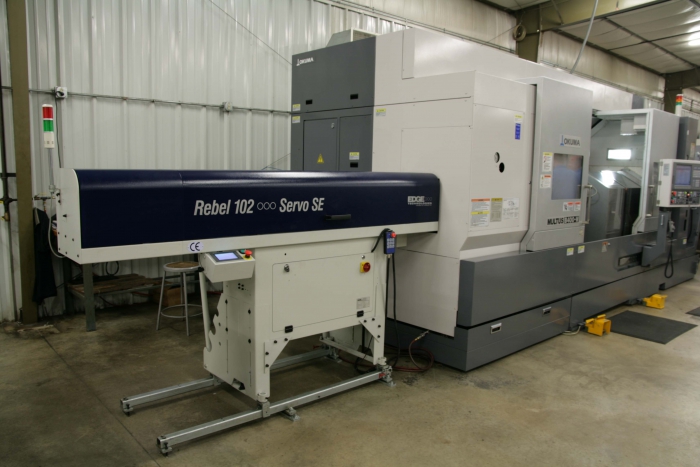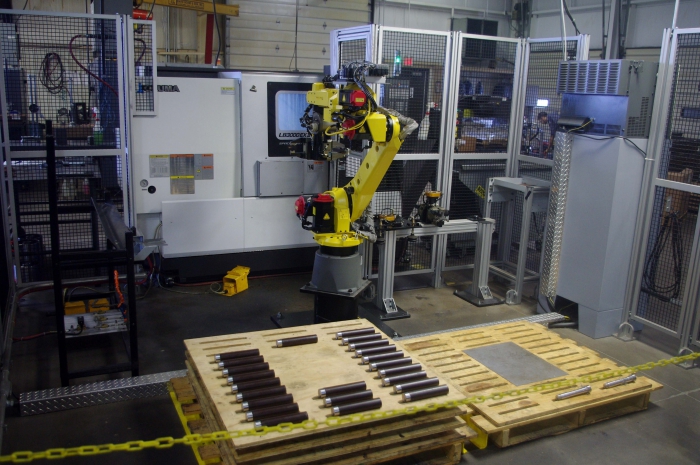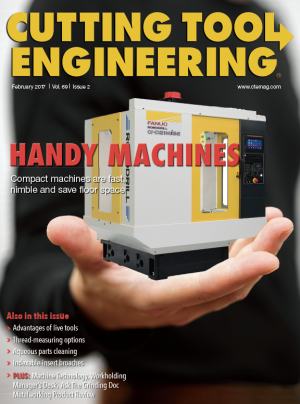To stay competitive, a growing number of parts manufacturers are opting to automatically feed their turning machines.
In recent years, for example, Charlotte, N.C.-based Okuma America Corp. has seen the number of lathes it sells with some type of automated material-feeding system go from 10 percent of the total to more than 30 percent, according to Jeff Estes, director of Okuma’s Partners in THINC, a supplier group that seeks to solve machining problems and boost productivity.
“I tell people that if you buy a lathe with a bar feeder, you are probably looking at $20,000 to $30,000 for the total package,” Estes said. But this investment “will pay for itself real quick.”

Okuma’s Multus B-400W turning center is paired with an Edge Technologies bar feeder.
Image courtesy of Okuma America.
How? The automatic bar feeder “isn’t going to leave after a 12-hour shift,” Estes noted. Instead, it can continue to operate unattended, feeding material into the machine tool for an additional 2 to 4 hours, depending on the part.
And when the plant is occupied, automatic feeding systems allow manufacturers to make better use of a valuable asset: their machinists. In traditional two- or three-machine work cells, a machinist would be placed in the middle of the machines. “There’s nothing wrong with having a qualified machinist there,” Estes said. “But where do you find these people anymore?”
So manufacturers are turning to automation to fill the skills gap, freeing up their trained personnel for machine setup and monitoring. “Now a person can monitor four or five machines that are being automatically fed, so you can spread the talent that you do find over more machines,” Estes said.
In the U.S., Estes noted, hundreds of thousands of bar feeders are helping machines run efficiently and effectively. Already proven and reliable, bar-feeder technology is being improved to simplify setup and product changeovers.
On the downside, however, the movement of large metal bars on the plant floor requires forklifts and wide aisles. In addition, the bar feeders themselves can be quite large and consume valuable floor space. A feeder for 12' bars, for example, is approximately 14' long.
Therefore, some automation-minded manufacturers are rejecting bar feeders in favor of systems that load sawed metal slugs into their machines. “In many cases, you can put two slug-feeding machines in the space taken up by one bar feeder,” Estes said. “So if floor space is critical, slug loading is a good way to increase your capacity in the same footprint.”
Some slug loaders feed slugs through the machine’s “front door” while also catching finished parts and placing them on an out-feed conveyor. Front-door slug loaders are becoming more popular because many people prefer to cut their stock beforehand instead of inside the machine, said Dennis Toellner, CEO of Toellner Systems Inc., Milwaukee, which makes automated slug loaders for CNC machines. According to Toellner, these systems typically load slugs in 7 to 9 seconds and don’t add part-off time to machining time.

A robot loads slugs into an Okuma LB-3000EX lathe. Image courtesy of Okuma America.
Another slug-loader option is an automated pick-and-place system that employs a simple robot to load and unload the slugs. Estes pointed out that these systems are more flexible than front-door slug loaders, thanks in part to the robot’s end effectors, which can adapt to different part sizes and configurations.
A slug-loading robot can be placed next to a machine or overhead as part of a gantry-type configuration, which takes up less floor space.
According to Toellner, slugging is often the choice for machining big parts that would require relatively long, heavy bars. However, though they may be difficult to handle, bars can be fed directly into a machine while slug users must either purchase precut raw material or pay someone to saw slugs in-house. In addition, Estes noted, slug loaders are more expensive than bar feeders—and the robotic type are significantly more.
But whether the choice is a bar feeder or slug loader, he said, “your machine will be utilized more, and your machinists will be more productive.”
Related Glossary Terms
- computer numerical control ( CNC)
computer numerical control ( CNC)
Microprocessor-based controller dedicated to a machine tool that permits the creation or modification of parts. Programmed numerical control activates the machine’s servos and spindle drives and controls the various machining operations. See DNC, direct numerical control; NC, numerical control.
- feed
feed
Rate of change of position of the tool as a whole, relative to the workpiece while cutting.
- lathe
lathe
Turning machine capable of sawing, milling, grinding, gear-cutting, drilling, reaming, boring, threading, facing, chamfering, grooving, knurling, spinning, parting, necking, taper-cutting, and cam- and eccentric-cutting, as well as step- and straight-turning. Comes in a variety of forms, ranging from manual to semiautomatic to fully automatic, with major types being engine lathes, turning and contouring lathes, turret lathes and numerical-control lathes. The engine lathe consists of a headstock and spindle, tailstock, bed, carriage (complete with apron) and cross slides. Features include gear- (speed) and feed-selector levers, toolpost, compound rest, lead screw and reversing lead screw, threading dial and rapid-traverse lever. Special lathe types include through-the-spindle, camshaft and crankshaft, brake drum and rotor, spinning and gun-barrel machines. Toolroom and bench lathes are used for precision work; the former for tool-and-die work and similar tasks, the latter for small workpieces (instruments, watches), normally without a power feed. Models are typically designated according to their “swing,” or the largest-diameter workpiece that can be rotated; bed length, or the distance between centers; and horsepower generated. See turning machine.
- sawing machine ( saw)
sawing machine ( saw)
Machine designed to use a serrated-tooth blade to cut metal or other material. Comes in a wide variety of styles but takes one of four basic forms: hacksaw (a simple, rugged machine that uses a reciprocating motion to part metal or other material); cold or circular saw (powers a circular blade that cuts structural materials); bandsaw (runs an endless band; the two basic types are cutoff and contour band machines, which cut intricate contours and shapes); and abrasive cutoff saw (similar in appearance to the cold saw, but uses an abrasive disc that rotates at high speeds rather than a blade with serrated teeth).
- turning
turning
Workpiece is held in a chuck, mounted on a face plate or secured between centers and rotated while a cutting tool, normally a single-point tool, is fed into it along its periphery or across its end or face. Takes the form of straight turning (cutting along the periphery of the workpiece); taper turning (creating a taper); step turning (turning different-size diameters on the same work); chamfering (beveling an edge or shoulder); facing (cutting on an end); turning threads (usually external but can be internal); roughing (high-volume metal removal); and finishing (final light cuts). Performed on lathes, turning centers, chucking machines, automatic screw machines and similar machines.


